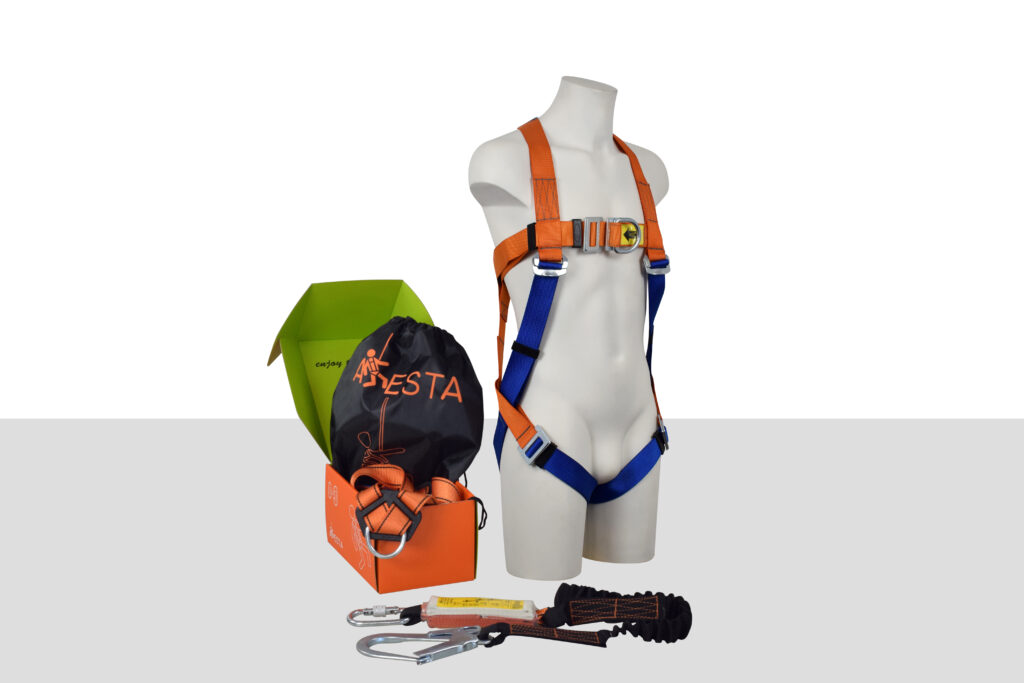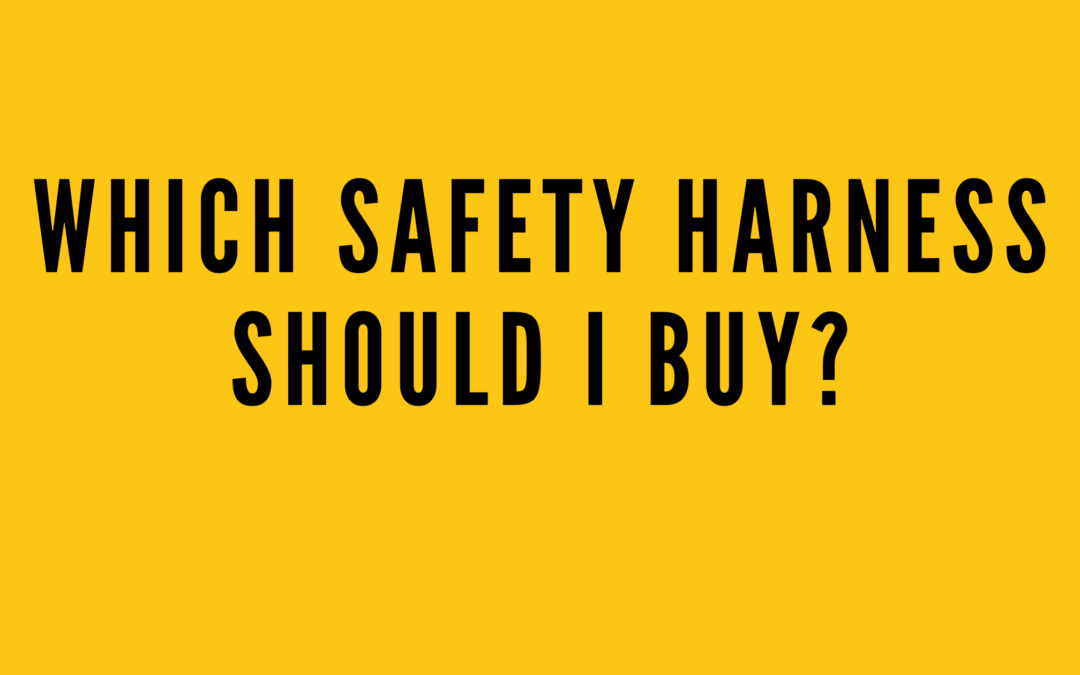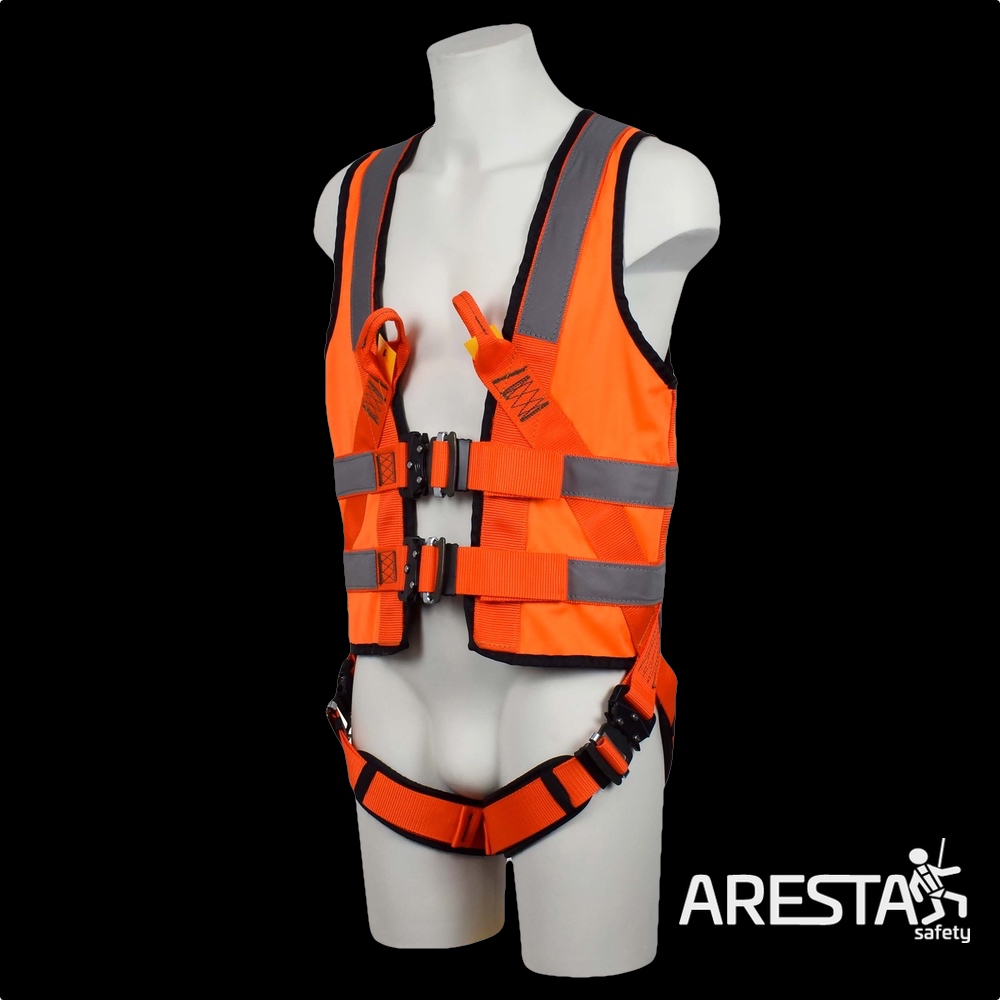I need a safety harness… What safety harness should I buy? This is a question that many people ask themselves when they are looking to purchase safety equipment for their job working at height. It is not an easy question to answer, as there are so many different types of safety harnesses on the market today from various manufacturers and with all sorts of features. In this blog post, we will help you find the best safety harness for your needs!
Safety harnesses today come in a variety of styles, from full body safety vests and “B” type safety belts to more specialized safety equipment like fall arrest systems for rope access work or industrial safety harnesses. Each style has its advantages and disadvantages that are worth considering before you make your purchase.
Full Body Safety Harnesses:
Safety harnesses that cover the entire body, from head to toe. They have a number of advantages including being lightweight and easy to put on as well as having lots of attachment points for safety lanyards or other safety equipment. The disadvantages are mostly related to air flow – they can be hot in warm weather conditions and some people find them too restrictive when it comes to movement

B Type Safety Belts:
Safety belts with loops at either end secured around your waist. These types of safety harnesses come in both full body versions meant for use while climbing large structures such as cranes or building frames, or shorter versions which might work better if you’re working out on scaffolding close by the ground. Their advantage is that they can be fitted quickly, adjusted to the size of your body and used in a variety of safety situations. They are also lightweight which is an advantage for long climbing sessions or work days
Fall Arrest Systems:
Safety harnesses with lines that are designed to catch you if you lose footing – these safety equipment setups come in two types; those intended for use near ground level such as on scaffolds, ladders and stairs, and those meant for high elevation work like rope access. The advantages of this type of safety harness are obvious – it will protect against falls from cable roofs or heights more than 20 feet off the ground. They’re also usually extremely light weight and easy to set up making them great for extended periods away from the ground. It’s worth noting, though, that safety harnesses with fall arrest systems will not protect you from falls on level ground or during the descent of a ladder.
Industrial Safety Harnesses:
Safety equipment designed to be used by workers in heavy industry such as construction and mining. These safety harnesses are often heavier duty which makes them more durable for use in industrial environments but also means they have higher safety requirements when it comes to testing before being certified.
How do I choose a safety harness?
The safety harnesses that you choose will depend on your needs and the environment in which you work. If you are doing high-level rope access, fall arrest systems might be a good option to help ensure safety while working at height; if not, then it’s probably best to stick with an industrial safety harness for those heavy duty jobs.
There is no “best” premium safety harness – only one that fits your individual needs as well as what type of job or activity we’re talking about! The key thing to remember when choosing safety equipment for yourself or others is this:
You should always wear appropriate personal protective equipment (PPE) based on the hazard assessments carried out by professionals before starting any job involving risks . This includes wearing a safety harness, safety helmet and safety gloves.
A full-body safety harness will be lightweight and easy to put on as well as having lots of attachment points for other safety equipment (e.g., lanyards). The disadvantages are mostly related to air flow – they can be hot in warm weather conditions or some people may find them too restrictive when it comes to movement.
B type safety belts with loops at either end secured around your waist come in both full body versions meant for use while climbing large structures such as cranes or building frames, or shorter versions which might work better if you’re working out on scaffolding close by the ground. Their advantage is that they can be fitted quickly, adjusted to the size of your body.
At what height do you need to wear a safety harness?
Any safety harness you choose should be worn at all times when working on a high-risk activity such as climbing. The height safety limit is about 20 feet off the ground – this can include cables or anything higher than that while not in use, but once work starts then only wear it if there’s a risk of falls from heights greater than 20 ft. You might also need to wear an industrial safety harness for heavy duty jobs like construction and mining which are designed with more durability features
Safety Harnesses: Summary:
There is no one “best” safety harness – each person needs to look into their individual situation and see what type they would feel most comfortable wearing. This includes taking note of the environment where you will be using your
What is the lifespan of a safety harness?
Safety harnesses come with different safety ratings, and the lifespan is related to this safety rating. The higher safety rating, the longer it will last before its no longer fit for use or you need a replacement.
What are some of the disadvantages of safety harness?
– They can be hot in warm weather conditions – they can restrict your movement when used as full body safety gear
How do I choose between industrial safety harness and rope access safety harness?
This really depends on what type of work you’re doing. If you want maximum durability then an industrial safety strap would be best suited; if not then a premium roped access one might suit better as it’s lighter weight than an industrial one but has more protection features like fall arrest systems.
What is the best fall protection harness?
There is no such thing as the “best safety harness” – only one that fits your individual needs and what type of work you’re doing.
What safety equipment should I wear?
Always wear appropriate personal protective equipment (PPE) based on hazard assessments carried out by professionals before starting any job involving risks, which includes wearing a safety harness, safety helmet, and safety gloves.
Can I choose between full body or B-type safety belts with loops at either end secured around my waist?
The choice really depends on what kind of environment you are working in; if it’s hot for example then a fully encasing safety belt might be too warm to use but will offer more protection. If not using something like high level rope safety equipment, then a safety belt with loops would be best.
How do I choose between safety harnesses and safety straps?
Safety belts can provide short-term safety for you while working off the ground – this is because they are light weight but also offer more protection than that of rope access safety gear like lanyards or slings. If looking at longer term use though, when doing work from heights greater than 20 ft., then a full body safety harness will be needed as well as fall arrest systems (e.g., scaffold netting).
What does it mean if my safety harness says “PANEL LOAD CAPACITY” on the back?
This means what weight your industrial type safety strap should carry. The safety harness should have the PANEL LOAD CAPACITY printed on it anywhere in between 300lbs and 500lbs.
What are some safety precautions I need to take with safety belts?
– Safety belts can become twisted quite easily, so ensure that when you’re putting them on they don’t get hooked up over anything, such as a strap or your arms
– Always read instructions for how to use safety belts properly before using – this includes making sure loops at either end of the belt are secured around waist securely and not loose; never wear safety straps without securing these loops first
– Never lean back against safety harnesses or slings while working. It’s best if you can work with shoulders pulled forward once wearing any safety safety straps
– Always inspect safety belts before you start using them for any defects – this includes checking that loops at either end of belt are secured around waist securely and not loose; never wear safety harnesses without securing these loops first. Safety belts should also be inspected after every use to check for signs of wear or damage, which would mean they’re no longer safe to work with
How do I know if my safety belt is twisted?
Safety belts can become very easily tangled up in itself due to the design – so it’s important when putting one on that it doesn’t get hooked over anything like a strap or your arm as this could result in injury. Inspecting safety equipment regularly (see above) will help prevent accidents from occurring.
Where is safety equipment required?
Safety harnesses are not just for people working at height – they’re also necessary when you need to work in an environment where there’s a risk of falling, such as scaffold netting systems or any other areas that have the potential for slips and falls.
What safety precautions should I take with safety belts?
– Safety belts can become twisted quite easily if it isn’t being used properly, so ensure that loops at either end of belt are secured around waist securely and not loose; never wear safety straps without securing these loops first
– Never lean back against safety belts while wearing them on your body (this doesn’t apply to rope access safety gear like lanyards)
What item is an example of fall protection?
Fall safety protection equipment like safety harnesses are essential when working at height such as scaffold netting systems or any other areas that have the potential for slips and falls.
What should I do if my safety belt has a defect?
If you notice any signs of wear, damage, or defects then stop using your safety belt immediately – this includes checking loops at either end of belt are secured around waist securely and not loose; never wear safety belts without securing these loops first
How can safety straps help me stay safe?
Safety straps/belts allow workers to lift heavy items on their own which is much safer than trying to use cranes in post-industrial environments where there’s no electricity
Are safety belts made out of the same safety material as safety harnesses?
No, safety belts are made out of much thicker fabric and webbing that’s designed to withstand high levels of tension
What happens if I’m working on a faulty scaffold netting system?
If the safety equipment you’re using for your height protection is not safe or has defects then there could be a risk of injury – so make sure all safety gear used in these types of situations is inspected before use. For example, if you realise one side of rope access safety belt strap doesn’t have any stitching after inspection it should be thrown away immediately because this means it can no longer provide the necessary level of fall protection required. Thoroughly inspecting/inspecting and replacing damaged safety ropes with new safety ropes should also be done on a regular basis.
Safety belts are essential when working at height, for example scaffold netting systems or any other areas that have the potential for slips and falls. They’re designed to withstand high levels of tension – so if you need help lifting heavy items while working at height safety straps will do this much better than cranes which no longer work in post-industrial environments where there’s no electricity supply available. Safety belts can become very easily tangled up due to their design (never wear safety harnesses without securing these loops first). In addition, safety equipment used in these types of situations is not safe or has defects then there could be a risk of injury; it’s important all safety gear used here is inspected before use. For example, safety ropes should be thoroughly inspected for any signs of wearing and replaced with new safety belts on a regular basis so that the necessary level of fall protection is maintained in case there’s an accident.
How do you inspect safety equipment?
– Ensure safety device like lanyard or harness isn’t overly worn
– Check all buckles are secure: this includes checking loops at either end – if these aren’t secured then stop using safety device immediately because it may not work/protect as intended (never wear safety belt without securing these loops first)
– Inspect woven material to ensure stitching hasn’t come undone; make sure no threads have been broken off from weave when inspecting webbing safety belts
– Check safety equipment is clean and free from any substances, such as oil or grease. If safety device has been used in high temperatures then it should be washed with soap to remove all build up of harmful residues
How do I make sure my safety belt doesn’t get tangled?
Safety harnesses have loops at either end that are secured around the waist securely – never wear safety belts without securing these loops first. The reason for this is because they can become very easily entangled due to their design (safety ropes should also be checked thoroughly before use). In addition, if you’re wearing a safety rope/belt on your body make sure its webbing strap isn’t too tight because this could restrict blood flow; instead, ensure it’s secured to the safety harness so it doesn’t move around on your body.
– The safety material used for safety belts is much thicker and designed to withstand high levels of tension – as opposed to safety belts which are made out of thinner fabric/webbing but not as strong; this means that safety ropes should be thoroughly inspected before use. For example, if you notice one side of a safety rope has no stitching after inspection or threads have been broken off from its weave then it shouldn’t be used because it can no longer provide sufficient protection during falls at height (never wear safety belt without securing these loops first)
– Safety equipment like lanyard or harness isn’t overly worn when checking for defects while making safety safety. If safety device has been used in high temperatures then it should be washed with soap to remove all build up of harmful residues
– The safety material for safety belts is much thicker and designed to withstand higher levels of tension – as opposed to safety belt which are made out of thinner fabric/webbing but not as strong; this means that safety ropes should be thoroughly inspected before use. For example, if you notice one side on a safety rope has no stitching after inspection or threads have broken off from its weave then it shouldn’t be used because it can no longer provide sufficient protection during falls at height (never wear safety belt without securing these loops first)




